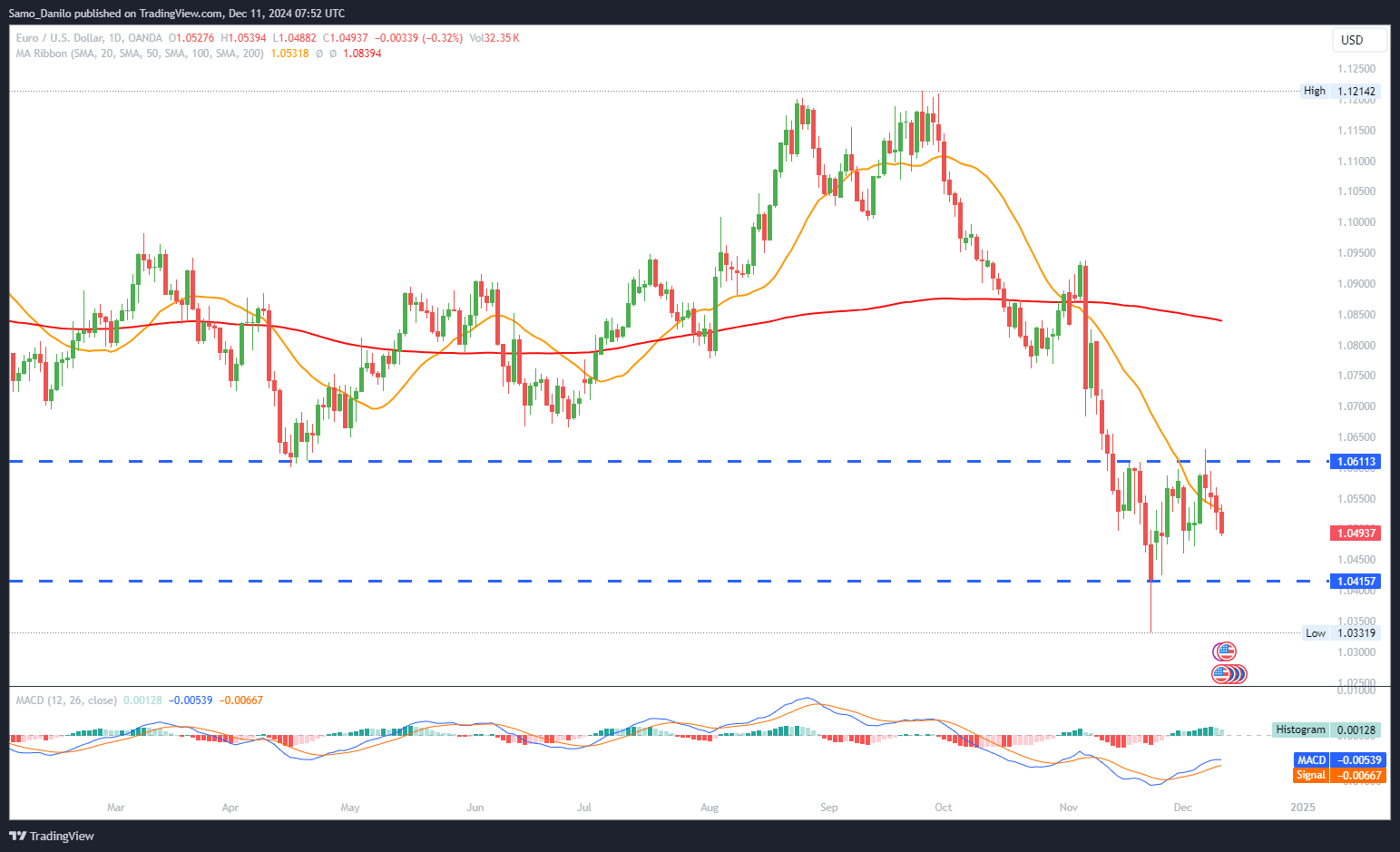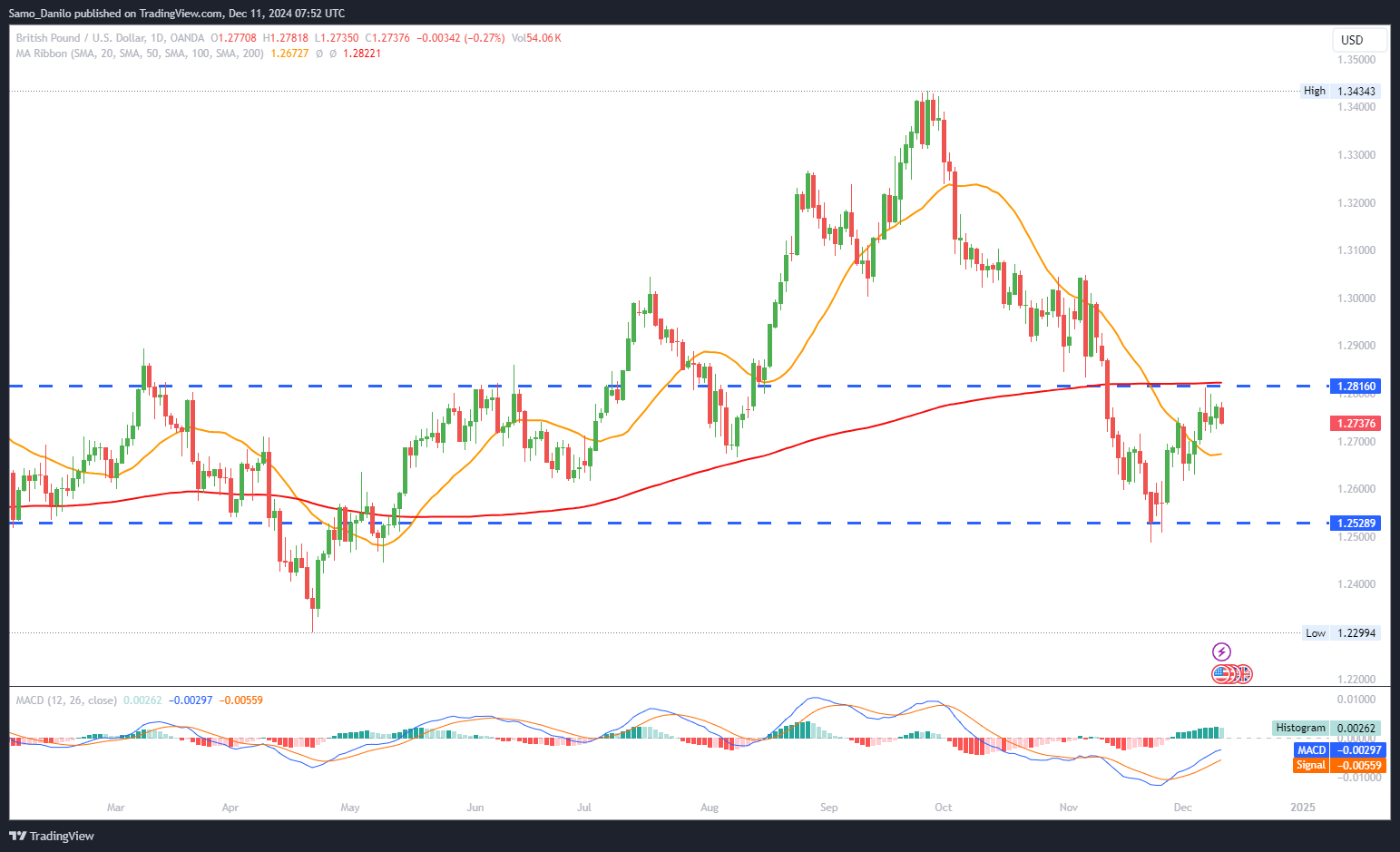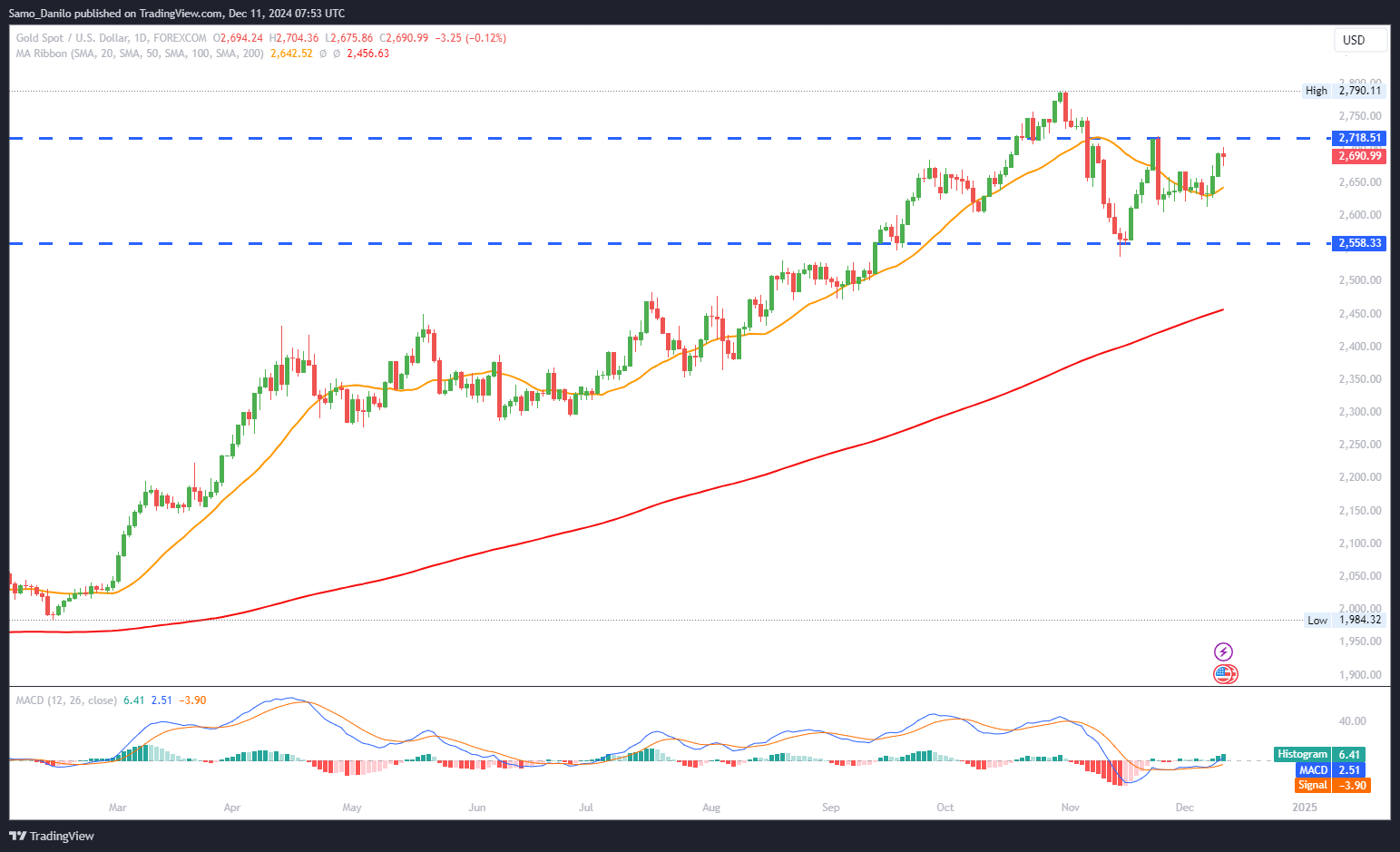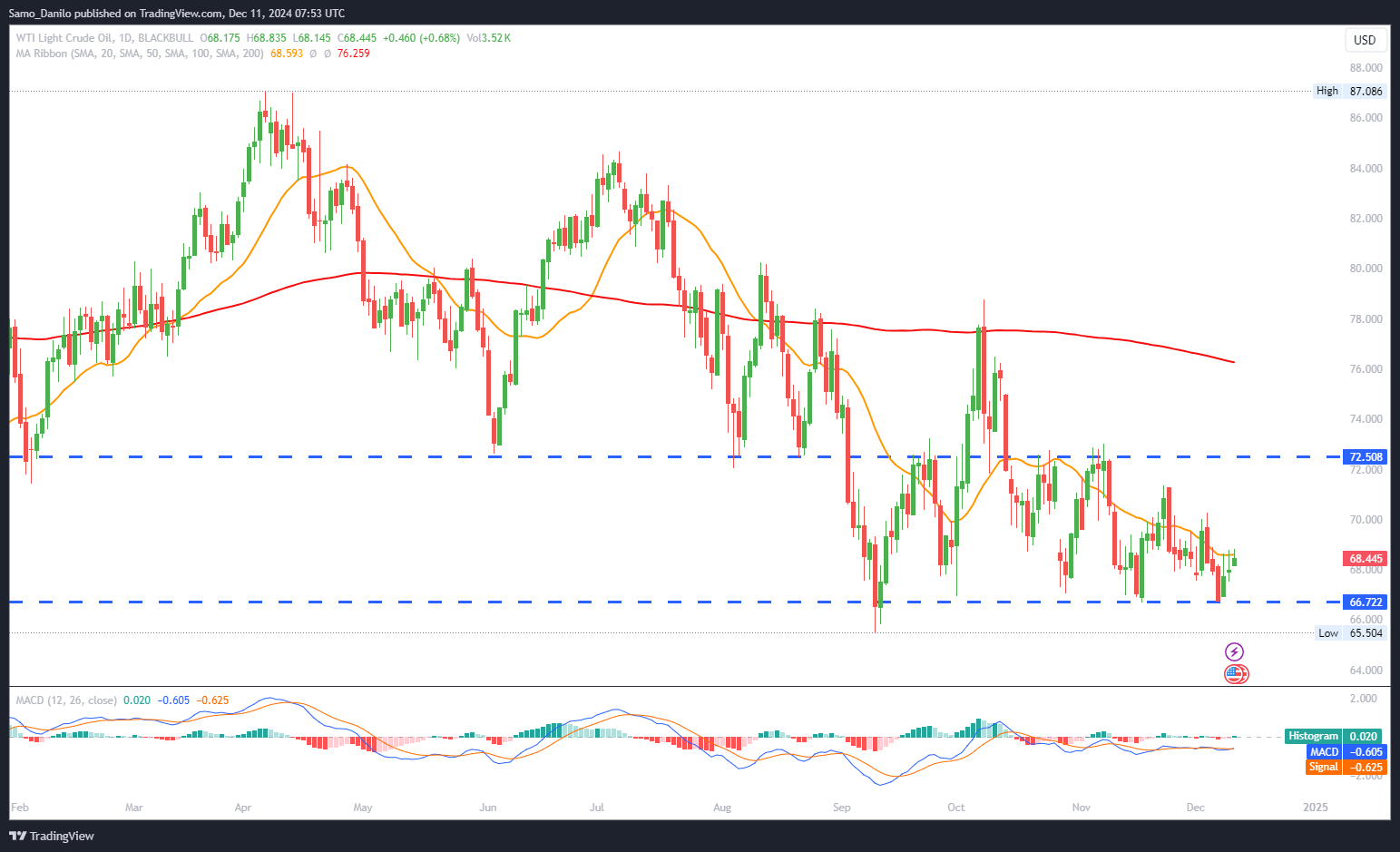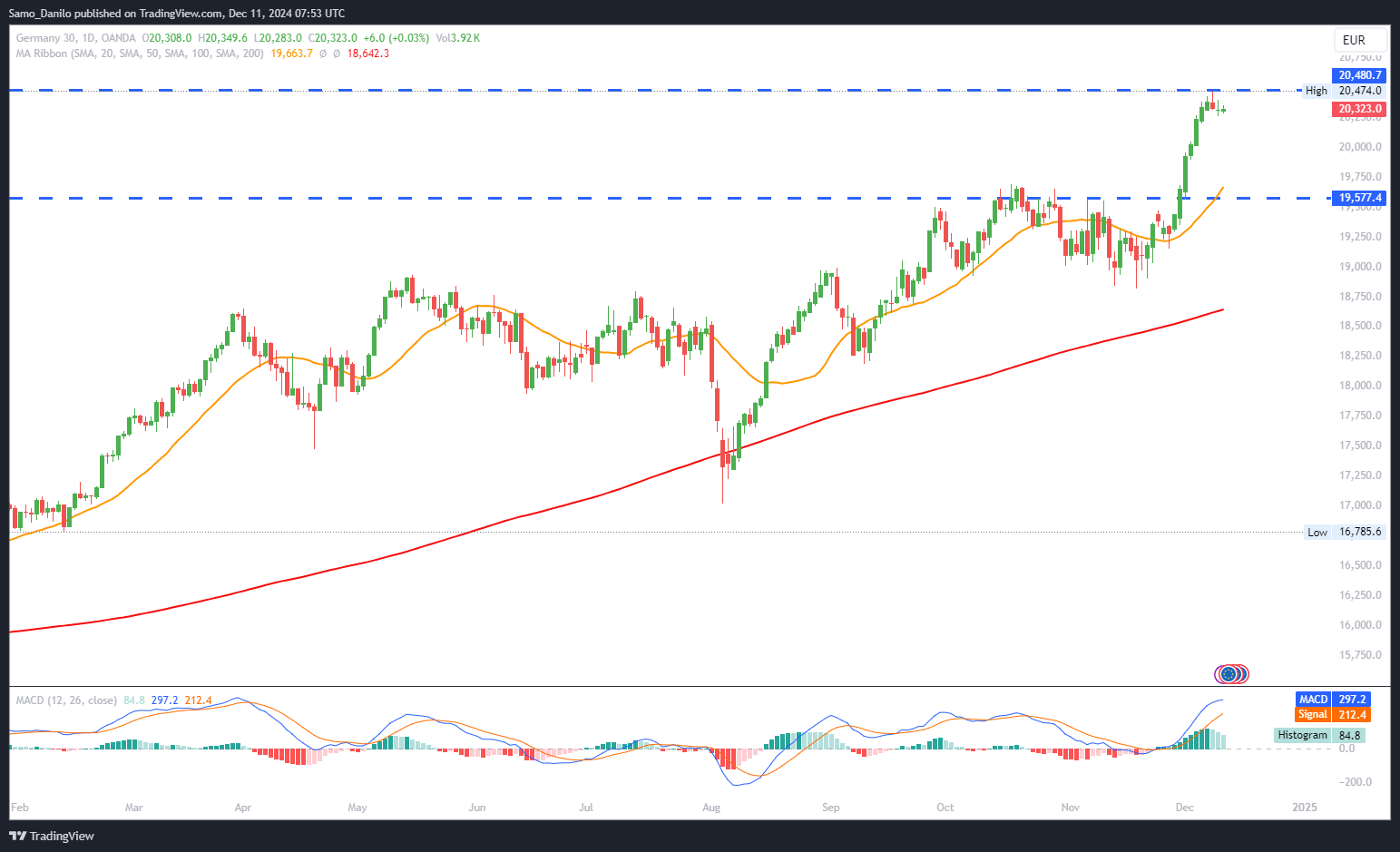EURUSD
- EUR/USD Price: The EUR/USD remains subdued for the fourth consecutive session, trading near 1.0520 on Wednesday. A lack of fresh bullish momentum amid a cautious market environment continues to weigh on the pair.
- ECB Rate Cut: Markets widely anticipate the European Central Bank (ECB) to lower the Deposit Facility Rate to 3.0% from 3.25%, marking its third consecutive reduction. The move reflects the eurozone's persistent economic challenges, including sluggish growth and weak demand.
- US Trade Policy: Proposed trade tariffs by President-elect Donald Trump could disrupt markets, raising US inflation and prompting a more hawkish Federal Reserve response. This scenario may further pressure the euro against the dollar.
- Fed Tone: Federal Reserve Chair Jerome Powell suggested that recent rate cuts might suffice for now, signaling a wait-and-see approach. This contrasts with the ECB’s expected easing, highlighting divergent policy paths between the two central banks.
- US CPI Data: The US CPI inflation for November is forecasted to rise to 2.7% YoY from 2.6%, with core CPI estimated at 3.3% YoY. Stronger inflation figures could bolster the US dollar, adding downside risks to EUR/USD.
Closing statement: EUR/USD faces headwinds from expected ECB rate cuts and stronger US economic fundamentals. Traders are eyeing Wednesday’s US CPI data and ECB announcements for clarity on the pair’s near-term trajectory. Continued policy divergence could keep the euro under pressure.
GBPUSD
- GBP/USD Price: GBP/USD extends its winning streak into a third session, trading near 1.2760 during Wednesday's European session. The pair benefits from sustained buying momentum and optimism around technical support levels.
- Technical Levels: GBP/USD has found stability above the 1.2750 mark, with the 200-period Simple Moving Average (SMA) at 1.2770 emerging as immediate resistance. A successful breach of this level could open the path toward the psychological barrier at 1.2800.
- BoE Signals: Bank of England (BoE) policymakers have signaled a cautious approach to reducing interest rates. Analysts, such as JP Morgan's Allan Monks, have highlighted very low odds of a rate cut next week, which supports the pound’s resilience in the short term.
- Light UK Calendar: With limited GBP-centric data this week, focus shifts to Wednesday’s US CPI inflation release for fresh catalysts. UK economic releases remain mid-tier, leaving GBP/USD movements primarily influenced by broader market trends.
- Fed’s Rate Cut: The CME’s FedWatch Tool indicates an 85% probability of a final quarter-point Fed rate cut this year. The dovish outlook for the Federal Reserve has added to US dollar softness, providing additional tailwinds for GBP/USD.
Closing statement: GBP/USD continues to capitalize on dollar weakness and technical momentum. Near-term focus remains on breaking the 1.2770 resistance while Wednesday’s US CPI inflation data could introduce volatility, influencing both dollar sentiment and broader market direction.
XAUUSD
- Gold Price: Gold price broke out of its consolidation phase, closing above the 50-day Simple Moving Average (SMA) at $2,670 on Tuesday. This bullish breakout indicates renewed upward momentum, positioning the metal to challenge further resistance levels.
- US CPI Data: Markets are anticipating a 2.7% year-on-year (YoY) increase in US CPI for November, up from October's 2.6%. Core inflation is expected to remain steady at 3.3% YoY. These figures, alongside a projected 0.3% month-on-month rise in both headline and core CPI, are critical for shaping Federal Reserve rate expectations.
- Safe-Haven Demand: Gold price recovery to its highest level since November 25 is supported by heightened safe-haven demand due to escalating Middle East tensions and the People’s Bank of China (PBOC) resuming gold purchases. This combination has reinforced bullish sentiment in the gold market.
- Geopolitical Tensions: The sudden collapse of the Syrian government has rattled global markets, driving investors toward the safety of gold. Meanwhile, Israel's military action against Syrian naval assets has added to geopolitical uncertainty, further fueling demand for the precious metal.
- PBOC Gold Purchases: The PBOC’s resumption of gold buying signals a potential long-term bullish trend for gold, as central bank acquisitions lend structural support to prices. This development is particularly significant given China’s influence on global commodity markets.
Closing statement: Gold prices are benefiting from a confluence of technical momentum, geopolitical uncertainties, and central bank demand. Near-term price action will likely be influenced by US CPI data, with sustained tensions in the Middle East providing underlying support. A breakout above recent highs could pave the way for further upside.
CRUDE OIL
- WTI Crude Oil Price: West Texas Intermediate (WTI), the US crude oil benchmark, trades around $68.70 during the European session on Wednesday. The price is supported by an improved demand outlook driven by Chinese policy announcements and favorable import data.
- China’s Policy Shift: Crude oil prices gained traction following China's Politburo announcement to adopt a "moderately loose" monetary policy and implement a "more proactive" fiscal stimulus strategy in 2024. This shift in policy bolsters expectations of increased energy demand from the world's largest oil importer.
- China’s Crude Oil Imports: For the first time in seven months, China’s crude oil imports rose significantly, increasing by over 14% year-on-year in November. This rebound in imports indicates a recovery in demand and provides a bullish signal for the global oil market.
- Rising US Stockpiles: The American Petroleum Institute (API) reported an increase of 0.499 million barrels in US crude oil stockpiles for the week ending December 6. While higher inventories typically weigh on prices, the market remains optimistic due to the demand-side improvements.
- OPEC Monthly Report: Market participants are closely monitoring the upcoming OPEC Monthly Oil Market Report (MOMR). This report will address global oil market dynamics and offer key forecasts for 2024, likely influencing crude oil price trends in the near term.
Closing statement: WTI crude oil prices are buoyed by China's stronger demand outlook and supportive fiscal policies. While rising US inventories present a potential headwind, the market's focus on upcoming OPEC forecasts and continued demand recovery could keep prices well-supported above $68 in the short term.
DAX
- DAX Retreats: On Tuesday, the DAX slipped by 0.08%, following a 0.19% loss on Monday. Notably, the index failed to reach a new record high for the first time in seven sessions, signaling a pause in bullish momentum.
- Auto Stocks: Auto stocks extended their rally for the third straight session, supported by speculation of fresh Chinese stimulus measures. Volkswagen gained 1.92%, Mercedes Benz Group rose by 0.99%, and BMW and Porsche also closed in positive territory. The stimulus-driven optimism boosted demand for German automakers, given their reliance on Chinese markets.
- Weak Chinese Trade: China’s trade data for November revealed a 6.7% year-on-year drop in exports, down sharply from October’s 12.7% growth. Imports also contracted at a faster rate, reflecting weaker domestic and overseas demand. This painted a challenging global economic backdrop and tested investor appetite for riskier assets like equities.
- Rising Inflation: Germany’s finalized inflation figures for November showed an annual inflation rate increase to 2.2%, up from 2.0% in October. The uptick in inflation adds complexity to the ECB’s decision-making process, potentially challenging market bets on multiple interest rate cuts.
- German Economy: Germany’s persistent economic struggles present a dilemma for the European Central Bank (ECB) ahead of Thursday’s policy meeting. Policymakers face the challenge of balancing higher inflation against signals of a slowing economy, particularly in Germany, the Eurozone's largest economy.
Closing statement: The DAX faces near-term headwinds from weak Chinese trade data and mixed signals from Germany's economy. While the rally in auto stocks highlights sector-specific strength, broader market sentiment remains cautious ahead of the ECB's upcoming interest rate decision. Further stimulus measures from China or clearer ECB guidance could provide fresh direction for the index.
